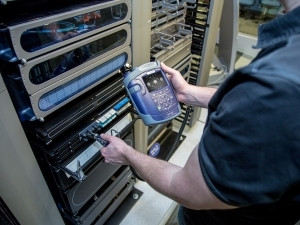Johannesburg, 24 Jul 2017

Arthur C Clarke famously said that a sufficiently-advanced technology can be indistinguishable from magic. It is easy to argue that his words have become the main characteristic of modern technology. Every day more and more people engage with sophisticated systems without realising the complexity behind their taps and swipes. Even the pipes that deliver data to them do not betray the incredible depth of skill and knowledge required to run an efficient network.
Fibre network operators certainly do acknowledge the complexity of the technology. They don't have much choice: installing, maintaining and testing fibre is loaded with technical challenges. This is particularly true with the rise of both fibre installations across the enterprise landscape, as well as the rapid growth of Multifibre Push On (MPO) connectors. These have delivered massive gains around space and capacity, but also increased the burden of testing fibre installations.
Testing in Tier 2 fibre environments has created several challenges, as detailed in Viavi's new whitepaper, Advances in Fibre Tier 2 Enterprise and Data Centre Testing, represented locally by Concilium Technologies. Though the paper starts with the reminder that pristine end-face conditions are critical for successful testing, it identifies four distinct problems facing modern fibre testing environments.
The first is accurate assessment of multimode fibre links, which notes the challenge of achieving proper multimode filling conditions. In other words, how to avoid under- or over-fill conditions, which inevitably lead to incorrect results.
The second challenge is how to reduce test times for multi-fibre interconnects. Multi-fibre interconnects still have to be manually tested one by one, consuming a lot of time - at least 40 minutes per strand.
Third is the concern that testing requires highly-trained technicians. By the paper's estimate, half of all OTDR (Optical Time Domain Reflectometer) errors result from operator mistakes, such improper settings or trace interpretations. Testing times and results could be greatly improved if the reading of results were simplified to accommodate a broader range of technicians.
Finally, the ability to test MPO breakout cassettes, which enable simplex and duplex connectors to be separated from multi-fibre connection signals, is daunting. This has a lot to do with the shorter cable length in a cassette, which isn't enough for effective reports from OTDR tests.
The paper from Viavi and Concilium recommends solutions to these scenarios. For example, to address filling conditions, an EF mode conditioner device can be inserted between the test source, such as an OTDR, and the fibre being tested. There are also methods to vastly reduce multi-fibre interconnects testing to as little as 20 minutes per strand. Lack of testing skills can be addressed through innovative new mapping software that converts the complexity of OTDR results into more intuitive schematics. And testing MPO breakout cassettes accurately becomes much easier with new high-resolution OTDR devices.
Technology may be magic for some, but the results dazzle when the magicians have more cards up their sleeves. Testing Tier 2 fibre shouldn't be a burden, but an opportunity. With the right tools and methodologies, it becomes much easier to pull that rabbit out of the hat and keep blowing customer minds.
To learn more, download Viavi's whitepaper, Advances in Fibre Tier 2 Enterprise & Data Center Testing, represented locally by Concilium Technologies. The document lays out both the technical nuance of the problems as well as the specific equipment solutions at hand. It also explores how combinations of these solutions can lead to huge efficiency and productivity gains around Tier 2 fibre testing.
Share